Analyzing the Effective Contributions of Local Governments in Promoting Regional Sustainable Development: Evidence from Hainan, China
Abstract
1. Introduction
2. Literature Review
2.1. The Concept of Sustainable Development
2.2. The Framework of Sustainable Development Goals (SDGs)
2.3. Local Governments and Regional Sustainable Development
3. Materials and Methods
3.1. Study Area
3.2. Evaluation Indicator System for Sustainable Development Level in Hainan Province
3.3. Data Sources
3.4. Research Methodology
3.4.1. Entropy Value Method
- (1)
- Data standardization
- (2)
- Calculate the characteristic weight of the jth indicator in year i as follows:
- (3)
- The information entropy of the jth indicator is calculated using the entropy formula:where n depends on the total number of years in the sample; ln is the natural logarithm.
- (4)
- Calculate the coefficient of variation for the jth indicator using the information entropy.
- (5)
- Calculate the weight of the jth indicator based on the coefficient of variation.
- (6)
- The composite evaluation score is calculated by performing a weighted summation.where U denotes the comprehensive evaluation score, m is the number of indicators, and is the weight of the jth indicator. A higher U-value indicates a better composite score and more favorable evaluation results. Ultimately, the evaluation results are compared based on all U-values [40].
3.4.2. Cluster Analysis Method
3.4.3. Policy Text Analysis Method
4. Results
4.1. Overall Level of Sustainable Development in Hainan Province
4.2. Describing the Level of Sustainable Development in Hainan Province from Each of the Six Dimensions
4.2.1. Significant Increase in Economic Strength
4.2.2. Continuous Improvement of People’s Livelihood
4.2.3. Overall Improvement in the State of the Resource Environment
4.2.4. Consumption and Emission Control Is Highly Effective
4.2.5. The Effectiveness of Governance and Protection Needs to Be Improved
4.2.6. The Level of Agricultural Development Needs to Be Improved
4.3. Comprehensive Evaluation Score and Ranking of Cities and Counties in Hainan Province
4.4. Cluster Analysis Results
5. Analysis of the Effective Contributions of the Hainan Provincial Government in Promoting Regional Sustainable Development
5.1. Hainan Provincial Government and Economic Development
5.1.1. Phase I, 2015, Marks the Final Year of the 12th Five-Year Plan
- Driving innovation. Deepen the reform of the scientific and technological system and stimulate the power and vitality of innovation. Driving the industry chain with the innovation chain, promoting the effective integration of science and technology with the economy, and boosting industrial development. Implementation of major provincial scientific and technological projects to accelerate key common technology research and development. Expanding openness and cooperation and improving the level of collaborative innovation. Vigorously develop crowdsourcing spaces to promote mass entrepreneurship and innovation.
- Structural optimization. Actively promote structural adjustment and transformation, focusing on the development of twelve industries. Tourism upgrading accelerated structural adjustment of agriculture, the Internet leading enterprises to speed up the layout of Hainan, aircraft financing and leasing, and other new forms of financial services continue to emerge, the real estate industry structure is gradually optimized, etc., and has begun to show results.
- Stabilizing growth. Grasp projects, promote investment, and promote stable and rapid economic growth. Establishment of the target management responsibility system, the implementation of monthly and quarterly assessments and inspections, to carry out the “100-day battle of investment projects”. Three hundred and ninety three provincial key projects complete the investment of CNY 191.5 billion, exceeding the annual plan by CNY 19.4 billion.
- Open development. Successfully organized major events such as the 2015 China-Korea Humanities Exchange Theme Provincial Road Activity, the Launching Ceremony of the “China-ASEAN Year of Maritime Cooperation”, and the International Regatta around Hainan Island. Strengthening cooperation and exchanges with relevant countries and regions along the route, the annual actual utilization of foreign capital of USD 2.47 billion, an increase of 28.7%.
5.1.2. Phase II, Spanning from 2016 to 2020, Corresponds to the 13th Five-Year Plan Period
- Driving innovation. China’s efforts to strengthen basic research and key core technologies have resulted in a steady flow of major innovations. “Chang’e” probes the moon, “Beidou” sets up a network, “Shenzhou” flies to the sky, and “Tianyan” patrols the sky, “Jiaolong” into the sea, “Kunlong” hits the water…several “national important weapons” have been unveiled. Original achievements with international influence have emerged in many fields, such as iron-based superconductivity, quantum information, stem cells, and synthetic biology.
- Structural optimization. Historic breakthroughs have been made in the structural transformation of the economy. The structure of the three industries is adjusted to 20.5:19.1:60.4, with the proportion of the service sector increasing by 6.4 percentage points and its contribution to economic growth reaching 95.8%, an increase of 31.5 percentage points. Tourism revenue achieves the 100 billion target one year ahead of schedule, with tourism revenue growing faster than the number of tourists by an annual average of 4.6 percentage points. High-tech enterprises have increased nearly four-fold, and the average annual growth rate of the size of the Internet industry has exceeded 30%.
- Stabilizing growth. Removing the economy’s dependence on real estate, the real estate industry’s value-added, investment, and tax revenue account for 4%, 21.9%, and 25.1% of the regional GDP, fixed-asset investment, and local general public budget revenue, respectively, falling from the highest level, but the economy has always maintained a stable and healthy development, and has successfully realized the breakthrough.
- Open development. Comprehensively deepening reform and opening up to a new level. The visa-free entry policy is extended to 59 countries, and the annual scale of inbound tourists has increased by 56%. The amount of actual utilized foreign capital doubled for three consecutive years. Thirty two colleges and universities have signed up and moved into the International Education and Innovation Island. Open platforms, such as the Boao Forum for Asia, have been consolidated and expanded, and the 2020 Joint Meeting of Chief Executives for Pan-Pearl River Delta Regional Cooperation has been successfully organized.
5.1.3. Phase III, Spanning from 2021 to 2023, Marks the Beginning of the 14th Five-Year Plan
- Driving innovation. Scientific and technological innovation has achieved breakthroughs. The Yazhou Bay Laboratory is up and running. The “Deepsea Warrior” successfully deployed a seafloor in situ scientific experiment station. A series of major launch missions for China’s space station are completed, and the country’s first commercial space launch site begins construction. Social investment in research and development (R&D) increased by nearly 50%.
- Structural optimization. Focusing on structural optimization, industrial investment increased by 33.5%, of which manufacturing investment increased by 84.2%. Consumption is upgraded in quality. The first China International Consumer Goods Fair was an instant success, with the degree of internationalization, the value of exhibits per unit area, and the number of debut exhibitions far exceeding expectations, making it the largest consumer boutique exhibition in the Asia-Pacific region.
- Stabilizing growth. The broader economy is stabilizing and improving. Two rounds of extraordinary actions have been carried out to stabilize the economy, special measures have been introduced to assist enterprises in their difficulties and development, and tax reductions and fee reductions totaling CNY 28.09 billion have been made to stabilize the economy. Industrial investment grows by 33%, increasing its share by 5.2 percentage points.
- Open development. The export-oriented economy is booming. The total import and export of goods is expected to exceed CNY 200 billion, an increase of 35%. Trade-in services increased by 21.6%. The actual use of foreign capital exceeds USD 4 billion, an increase of 15%. Actual outward investment of USD 1.7 billion doubled year-on-year.
5.2. Hainan Provincial Government and Social Livelihood Development
5.2.1. Phase I, 2015, Marks the Final Year of the 12th Five-Year Plan
- Education and culture. It has realized full coverage of public kindergartens in all townships, launched a project to introduce and cultivate good principals and teachers in primary and secondary schools, and added 4000 places in ordinary high schools. The scope of tuition exemption for secondary schools is expanded, the average per-pupil allocation standard for public higher vocational institutions is raised to CNY 12,000 per person per year, and CNY 30.92 million in living allowances are granted to nearly 10,000 teachers in the province’s arduous and remote areas.
- Social security. The province has realized the same system and the same treatment for rural residents and urban residents in old-age insurance, and the subsidy standard has been raised uniformly to CNY 145 per person per month, ranking among the highest in the country. The establishment of a major disease insurance system covering urban and rural residents and the realization of provincial-level coordination of the three medical insurance systems, namely, employees’ medical insurance, urban residents’ medical insurance, and maternity insurance.
- Health and wellness. Construction and improvement of food inspection and testing system. Solving the problem of safe drinking water for 150,000 rural residents. The provincial oncology hospital is completed and opened, and free national pre-pregnancy eugenic health examinations and thalassemia gene screening and diagnostic services are carried out. The comprehensive reform of county-level public hospitals has been comprehensively launched, and the pilot comprehensive reform of primary healthcare organizations has been solidly advanced.
- Degrees of parity. Rehabilitation of 44,000 dilapidated rural houses, exceeding the target set at the beginning of the year by 3.4 times, and commencement of the re-habilitation of 35,800 shantytowns. Implementing precise poverty alleviation, 86,000 people are lifted out of poverty. An additional 101,000 people are employed in urban areas. Comprehensively completing the construction of rural roads in ethnic areas and implementing financial interest subsidies of CNY 110 million for small loans to farmers throughout the province [48].
5.2.2. Phase II, Spanning from 2016 to 2020, Corresponds to the 13th Five-Year Plan Period
- Education and culture. Introducing and negotiating the cooperation of quality educational resources to run 104 schools. The indicators for preschool education are higher than the national requirements, the main indicators for primary and secondary education exceed the national average, and the ratio of large classes has been reduced to 0.49 percent. Vocational education covers 452 specializations in 32 categories. Higher education has an overall layout of “1 comprehensive university + 2 specialized universities + multiple universities”.
- Social security. Social insurance coverage has increased, with the basic pension insurance participation rate reaching 91%. A total of CNY 6.85 billion have been invested in social assistance for the needy, benefiting 1.6 million people in need. The rate of basic rehabilitation services for persons with disabilities has reached 100 percent. Newly adding 297,000 units of various types of housing with security functions, and launching a pilot program of residential commercial housing.
- Health and wellness. Elimination of malaria throughout the province. The introduction of 49 high-quality hospitals, the addition of seven new Grade 3A hospitals, “one hour three hospitals service circle” covering the province, the completion of the standardization of 1272 primary health care institutions, the addition of 22 kinds of Chinese and Western medical specialties do not go out of the island for treatment, “staying out of the city for minor illnesses and off the island for major ones” is starting to become a reality.
- Degrees of parity. The growth of people’s income outpaced the economic growth rate, and the income gap between urban and rural residents narrowed by 5.8 percent. The number of new urban jobs increased by 616,000, and the growth rate reached 29.2 percent.
5.2.3. Phase III, Spanning from 2021 to 2023, Marks the Beginning of the 14th Five-Year Plan
- Education and culture. A total of 83 primary and secondary kindergartens have been introduced, providing 160,000 quality places, as well as 40,000 new places in basic education. More than 200 mass cultural activities are organized to celebrate the 100th anniversary of the founding of the Party. Completion of the second phase of the provincial library, Hainan Science and Technology Museum, and the provincial art museum.
- Social security. The construction of 39,000 units of residential housing has begun and the first batch is successfully placed for sale, and 13,000 units of public rental housing are guaranteed. The special rectification of the real estate and housing rental market has been effective. The monthly per capita pension for retirees is increased by CNY 138. There are 3015 new beds for the elderly and 6735 nursery places for infants and children aged 0–3. Completing vocational skills training for 241,000 people.
- Health and wellness. Shanghai Jiao Tong University School of Medicine-affiliated Ruijin Hospital Hainan Hospital trial run, 50 provincial clinical medical centers and provincial capitals of public tertiary hospitals to speed up the implementation of the layout and construction, to achieve the “one-hour tertiary hospital service circle” province-wide coverage. It is the first in the country to realize a 5G remote diagnosis and treatment system covering all village (residential) health institutions.
- Degrees of parity. All 13,000 urban workers in difficulty have been relieved of their difficulties. Vigorous efforts have been made to organize farmers to go out to work to increase their incomes, with the growth rate of wage income increasing by 4.9 percentage points and the per capita disposable income of rural residents growing by 11 percent. The per capita disposable income of rural residents is expected to grow 5.5 percentage points faster than that of urban areas.
5.3. Hainan Provincial Government and Ecological Environment Development
5.3.1. Phase I, 2015, Marks the Final Year of the 12th Five-Year Plan
5.3.2. Phase II, Spanning from 2016 to 2020, Corresponds to the 13th Five-Year Plan Period
5.3.3. Phase III, Spanning from 2021 to 2023, Marks the Beginning of the 14th Five-Year Plan
5.4. Hainan Provincial Government and Social Governance Development
5.4.1. Phase I, 2015, Marks the Final Year of the 12th Five-Year Plan
5.4.2. Phase II, Spanning from 2016 to 2020, Corresponds to the 13th Five-Year Plan Period
5.4.3. Phase III, Spanning from 2021 to 2023, Marks the Beginning of the 14th Five-Year Plan
6. Discussion
6.1. A Discussion on the Overall Sustainable Development Level of Hainan Province from 2015 to 2023
6.2. A Discussion on the Sustainable Development Levels of the 18 Cities and Counties in Hainan Province in 2023
6.3. A Discussion on the Effective Contributions of the Hainan Provincial Government in Promoting Regional Sustainability
6.4. Limitations of the Study
7. Conclusions and Recommendations
7.1. Conclusions
7.2. Recommendations
Author Contributions
Funding
Institutional Review Board Statement
Informed Consent Statement
Data Availability Statement
Conflicts of Interest
References
- Stoddart, M.C.J.; Yang, Y.; Atlin, C. Regionalizing the sustainable development goals: Interpretations of priorities and key actors for creating sustainable island futures. Ecol. Soc. 2023, 28, 4. [Google Scholar] [CrossRef]
- Gianluca, Z.; Andreea, M.-P.; Larisa Loredana, D. European Sustainable Development Goals Reporting: A Qualitative Comparative Analysis on Cultural Impact. Econ. Comput. Econ. Cybern. Stud. 2024, 58, 258–275. [Google Scholar] [CrossRef]
- Halim, M.A.; Moudud-Ul-Huq, S. Green economic growth in BRIC and CIVETS countries: The effects of trade openness and sustainable development goals. Heliyon 2024, 10, e30148. [Google Scholar] [CrossRef]
- Masuda, H.; Okitasari, M.; Morita, K.; Katramiz, T.; Shimizu, H.; Kawakubo, S.; Kataoka, Y. SDGs mainstreaming at the local level: Case studies from Japan. Sustain. Sci. 2021, 16, 1539–1562. [Google Scholar] [CrossRef]
- Koh, J.; Huh, T.; Ye, M. Developing an index of sustainable development goals for local governments: The case of Gyeonggi province in korea. Ecosyst. Health Sustain. 2021, 7, 1980437. [Google Scholar] [CrossRef]
- Masuda, H.; Kawakubo, S.; Okitasari, M.; Morita, K. Exploring the role of local governments as intermediaries to facilitate partnerships for the Sustainable Development Goals. Sustain. Cities Soc. 2022, 82, 103883. [Google Scholar] [CrossRef]
- Płonka, A.; Dacko, M.; Satoła, Ł.; Dacko, A. The Idea of Sustainable Development and the Possibilities of Its Interpretation and Implementation. Energies 2022, 15, 5394. [Google Scholar] [CrossRef]
- Uquillas Granizo, G.G.; Mostacero, S.J.; Puente Riofrío, M.I. Exploring the Competencies, Phases and Dimensions of Municipal Administrative Management towards Sustainability: A Systematic Review. Sustainability 2024, 16, 5991. [Google Scholar] [CrossRef]
- Leavesley, A.; Trundle, A.; Oke, C. Cities and the SDGs: Realities and possibilities of local engagement in global frameworks. Ambio 2022, 51, 1416–1432. [Google Scholar] [CrossRef]
- World Commission on Environment and Development. Our Common Future; Oxford University Press: Oxford, UK, 1987. [Google Scholar]
- Xinzhang, S. Review and Prospect of the UN Efforts for Sustainable Development. Chin. J. Popul. Resour. Environ. 2012, 10, 31–38. [Google Scholar] [CrossRef]
- Shi, L.; Han, L.; Yang, F.; Gao, L. The Evolution of Sustainable Development Theory: Types, Goals, and Research Prospects. Sustainability 2019, 11, 7158. [Google Scholar] [CrossRef]
- Fang, X.; Zhou, B.; Tu, X.; Ma, Q.; Wu, J. What Kind of a Science is Sustainability Science? An Evidence-Based Reexamination. Sustainability 2018, 10, 1478. [Google Scholar] [CrossRef]
- United Nations. Transforming Our World: The 2030 Agenda for Sustainable Development; United Nations: New York, NY, USA, 2015; ISBN 9780826190123. [Google Scholar]
- Tanguay, G.A.; Rajaonson, J.; Lefebvre, J.-F.; Lanoie, P. Measuring the sustainability of cities: An analysis of the use of local indicators. Ecol. Indic. 2010, 10, 407–418. [Google Scholar] [CrossRef]
- Mori, K.; Christodoulou, A. Review of sustainability indices and indicators: Towards a new City Sustainability Index (CSI). Environ. Impact Assess. Rev. 2012, 32, 94–106. [Google Scholar] [CrossRef]
- ICLEI—Local Governments for Sustainability. ICLEI—Local Governments for Sustainability: ICLEI—Brochure; ICLEI: Bonn, Germany, 2016; p. 4. [Google Scholar]
- Nováček, P.; Mederly, P. How to Measure Progress Towards Quality and Sustainability of Life? Ekológia 2015, 34, 7–18. [Google Scholar] [CrossRef][Green Version]
- Braulio-Gonzalo, M.; Bovea, M.D.; Ruá, M.J. Sustainability on the urban scale: Proposal of a structure of indicators for the Spanish context. Environ. Impact Assess. Rev. 2015, 53, 16–30. [Google Scholar] [CrossRef]
- Dahl, A.L. Contributions to the evolving theory and practice of indicators of sustainability. In Routledge Handbook of Sustainability Indicators; Bell, S., Morse, S., Eds.; Routledge: London, UK, 2018; pp. 42–58. [Google Scholar]
- Zimmermann, F. Nachhaltigkeit wofür? In Von Chancen und Herausforderungen für Eine Nachhaltige Zukunft; Springer: Berlin, Germany, 2016; p. 288. [Google Scholar]
- Michalina, D.; Mederly, P.; Diefenbacher, H.; Held, B. Sustainable Urban Development: A Review of Urban Sustainability Indicator Frameworks. Sustainability 2021, 13, 9348. [Google Scholar] [CrossRef]
- Patole, M. Localization of SDGs through Disaggregation of KPIs. Economies 2018, 6, 15. [Google Scholar] [CrossRef]
- Salvador, M.; Sancho, D. The Role of Local Government in the Drive for Sustainable Development Public Policies. An Analytical Framework Based on Institutional Capacities. Sustainability 2021, 13, 5978. [Google Scholar] [CrossRef]
- Spangenberg, J.H. Indicators for sustainable development. In Routledge International Handbook of Sustainable Development; Redclift, M., Springett, D., Eds.; Routledge: London, UK, 2015; pp. 308–322. [Google Scholar]
- Cohen, M. A Systematic Review of Urban Sustainability Assessment Literature. Sustainability 2017, 9, 2048. [Google Scholar] [CrossRef]
- China Centre for International Economic Exchanges; Columbia University Earth Institute; Philips (China) Investment Co., Ltd.; Dadao Climate Change Response Promotion Centre. Evaluation Report on the Sustainable Development of China (2023), 1st ed.; Social Science Academic Press: Beijing, China, 2023; pp. 39–41. [Google Scholar]
- Ye, H.; Wang, H.; Nie, C.; Wang, J.; Huang, W.; Teng, L.; Wu, M. Measurement Indicators and an Evaluation Approach for Assessing the Sustainable Development Capacity of Tropical Agriculture: A Case Study for Hainan Province, China. Sustainability 2023, 15, 8778. [Google Scholar] [CrossRef]
- The People’s Government of Hainan Province. Overview of Hainan. Available online: https://www.hainan.gov.cn/hainan/hngl/201809/02b6b908146c4ce89c0dbd1fad7720a6.shtml?ddtab=true (accessed on 10 February 2025).
- The People’s Government of Hainan Province. Climatic Situation. Available online: https://www.hainan.gov.cn/hainan/qhqk/201701/f54b1ce75d1e4aae9103feefcb7bf026.shtml?ddtab=true (accessed on 10 February 2025).
- The People’s Government of Hainan Province. Topography and Geomorphology. Available online: https://www.hainan.gov.cn/hainan/dxdm/201701/1e8ee90b981f4ff4818fec2bab95c472.shtml?ddtab=true (accessed on 10 February 2025).
- The People’s Government of Hainan Province. On Behalf of the Members of the Heated Discussion of the “Three Poles, One Belt, One Region”: The Direction of the New Highlights Is Clearer. Available online: https://www.hainan.gov.cn/hainan/5309/202501/7bddf278f5774439b6ac61ef2d5c37d8.shtml (accessed on 10 February 2025).
- National Bureau of Statistics. China Statistical Yearbook (2016–2024); China Statistical Press: Beijing, China, 2024. Available online: https://www.stats.gov.cn/sj/ndsj/ (accessed on 27 April 2025).
- Hainan Provincial Bureau of Statistics. Hainan Statistical Yearbook (2016–2024); China Statistical Press: Beijing, China, 2024. Available online: https://stats.hainan.gov.cn/tjj/tjsu/ndsj/ (accessed on 27 April 2025).
- Department of Social, Science and Technology, and Cultural Statistics, National Bureau of Statistics. China Statistical Yearbook on Science and Technology (2016–2024); China Statistical Press: Beijing, China, 2024; Available online: https://data.cnki.net/yearBook/single?id=N2025020147&pinyinCode=YBVCX (accessed on 27 April 2025).
- Ministry of Ecology and Environment, National Bureau of Statistics. China Statistical Yearbook on Environment (2016–2024); China Statistical Press: Beijing, China, 2024; Available online: https://data.cnki.net/yearBook/single?id=N2024050561&pinyinCode=YHJSD (accessed on 27 April 2025).
- Department of Energy Statistics, National Bureau of Statistics. China Energy Statistical Yearbook (2016–2024); China Statistical Press: Beijing, China, 2024; Available online: https://data.cnki.net/yearBook/single?id=N2024050932&pinyinCode=YCXME (accessed on 27 April 2025).
- Department of Ecology and Environment of Hainan Province. Hainan Ecological and Environmental Bulletin (2015–2023). Available online: https://hnsthb.hainan.gov.cn/hjzl/hjzlxx/hjzkgb_51008/ (accessed on 27 April 2025).
- Lin, W.; Hong, C.; Zhou, Y. Multi-Scale Evaluation of Suzhou City’s Sustainable Development Level Based on the Sustainable Development Goals Framework. Sustainability 2020, 12, 976. [Google Scholar] [CrossRef]
- Wang, T.; Wang, D.; Zeng, Z. Research on the Construction and Measurement of Digital Governance Level System of County Rural Areas in China—Empirical Analysis Based on Entropy Weight TOPSIS Model. Sustainability 2024, 16, 4374. [Google Scholar] [CrossRef]
- Kanzari, E.; Fazio, G.; Fricano, S. Analysing the energy landscape in Africa using cluster analysis: Drivers of renewable energy development. Energy Policy 2024, 195, 114366. [Google Scholar] [CrossRef]
- Zamawe, F.C. The Implication of Using NVivo Software in Qualitative Data Analysis: Evidence-Based Reflections. Malawi Med. J. 2015, 27, 13–15. [Google Scholar] [CrossRef] [PubMed]
- Yang, J.; Huang, G.; Xue, D. The Changing Roles of the Local Government in Environmental Governance in Guangzhou, China. Pol. J. Environ. Stud. 2024, 33, 1401–1412. [Google Scholar] [CrossRef]
- Petushkova, V.V. China’s Experience and Prospects for Sustainable Development. Her. Russ. Acad. Sci. 2022, 92, 207–215. [Google Scholar] [CrossRef]
- Wang, B.; Liu, F.; Yang, S. Green economic development under the fiscal decentralization system: Evidence from China. Front. Environ. Sci. 2022, 10, 955121. [Google Scholar] [CrossRef]
- Meng, X.; Ding, T.; Wang, H. Incentives for local government expenditures on people’s livelihood: The role of high-speed rail. Socio-Econ. Plan. Sci. 2023, 89, 101700. [Google Scholar] [CrossRef]
- Pu, G.; Chang-Richards, A.Y. Livelihood recovery for sustainable development: A study of the Lushan earthquake. Int. J. Disaster Risk Reduct. 2022, 82, 103317. [Google Scholar] [CrossRef]
- Su, F.; Song, N.; Ma, N.; Sultanaliev, A.; Ma, J.; Xue, B.; Fahad, S. An Assessment of Poverty Alleviation Measures and Sustainable Livelihood Capability of Farm Households in Rural China: A Sustainable Livelihood Approach. Agriculture 2021, 11, 1230. [Google Scholar] [CrossRef]
- Liu, H.; Zhou, R.; Yao, P.; Zhang, J. Assessing Chinese governance low-carbon economic peer effects in local government and under sustainable environmental regulation. Environ. Sci. Pollut. Res. 2023, 30, 61304–61323. [Google Scholar] [CrossRef] [PubMed]
- Du, J.; Zhu, X.; Li, X.; Ünal, E.; Longhurst, P. Explaining the Green Development Behavior of Local Governments for Sustainable Development: Evidence from China. Behav. Sci. 2023, 13, 813. [Google Scholar] [CrossRef] [PubMed]
- The People’ Government of Hainan Province. Work Report of Hainan Provincial People’s Government in 2016. Available online: https://www.hainan.gov.cn/hainan/szfgzbg/201602/d9aecd65483e4b7b978dd14d08b11137.shtml?ddtab=true (accessed on 12 March 2025).
- The People’ Government of Hainan Province. Work Report of Hainan Provincial People’s Government in 2021. Available online: https://www.hainan.gov.cn/hainan/szfgzbg/202102/40b0485136d642a7b9c5454bffe85fdb.shtml?ddtab=true (accessed on 12 March 2025).
- The People’ Government of Hainan Province. Work Report of Hainan Provincial People’s Government in 2022. Available online: https://www.hainan.gov.cn/hainan/szfgzbg/202201/6da8f2ca08ce440792389398d9a78459.shtml?ddtab=true (accessed on 12 March 2025).
- The People’ Government of Hainan Province. Work Report of Hainan Provincial People’s Government in 2023. Available online: https://www.hainan.gov.cn/hainan/szfgzbg/202301/d0465d7368334abfa40b7db6b982720c.shtml?ddtab=true (accessed on 12 March 2025).
- Bulmer, E.; del Prado-Higuera, C. Revitalizing the Global Alliances for Sustainable Development: Analyzing the Viability of Sustainable Development Goal 17—A Multi-Actor Governance Approach. Sustainability 2021, 13, 4247. [Google Scholar] [CrossRef]
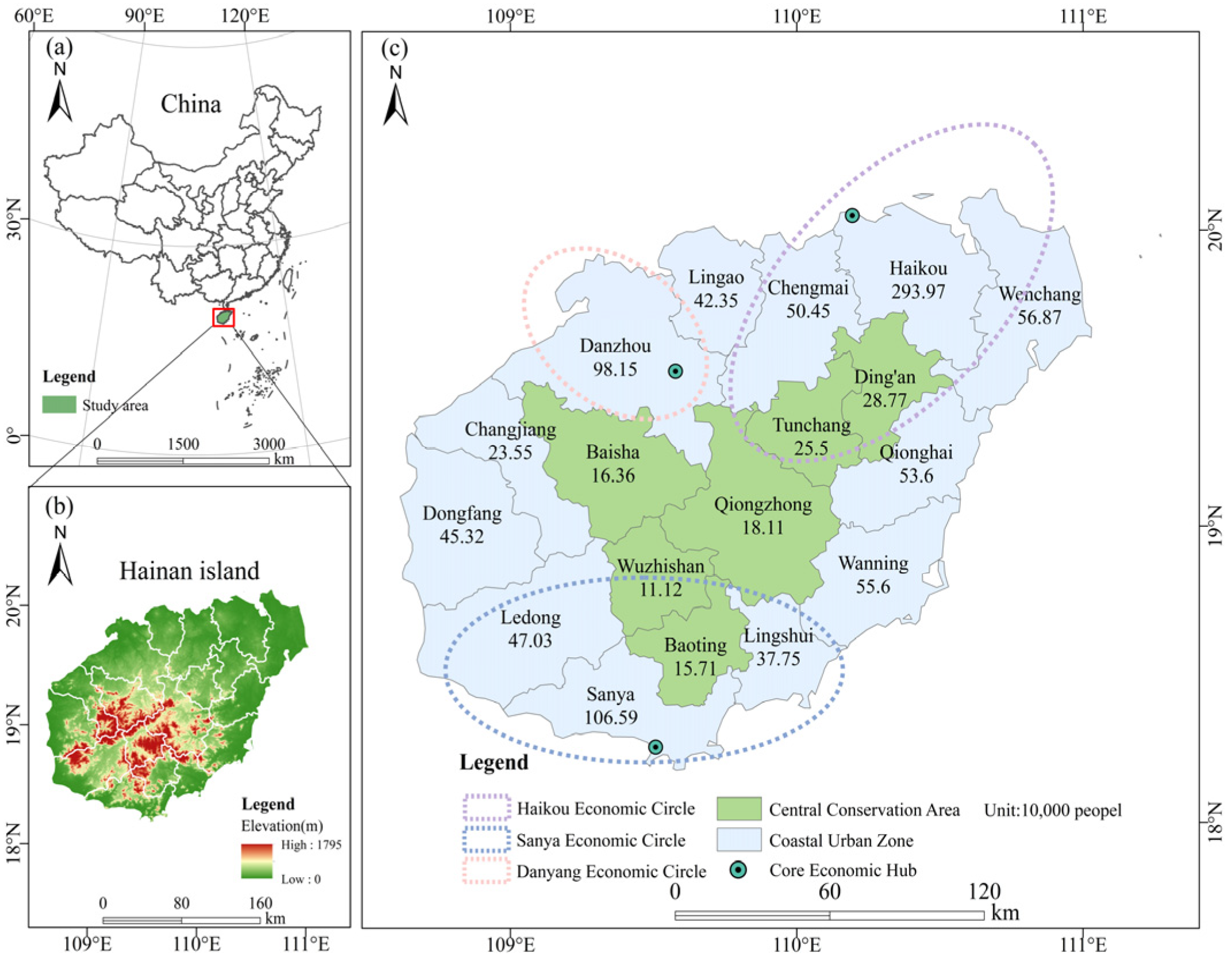
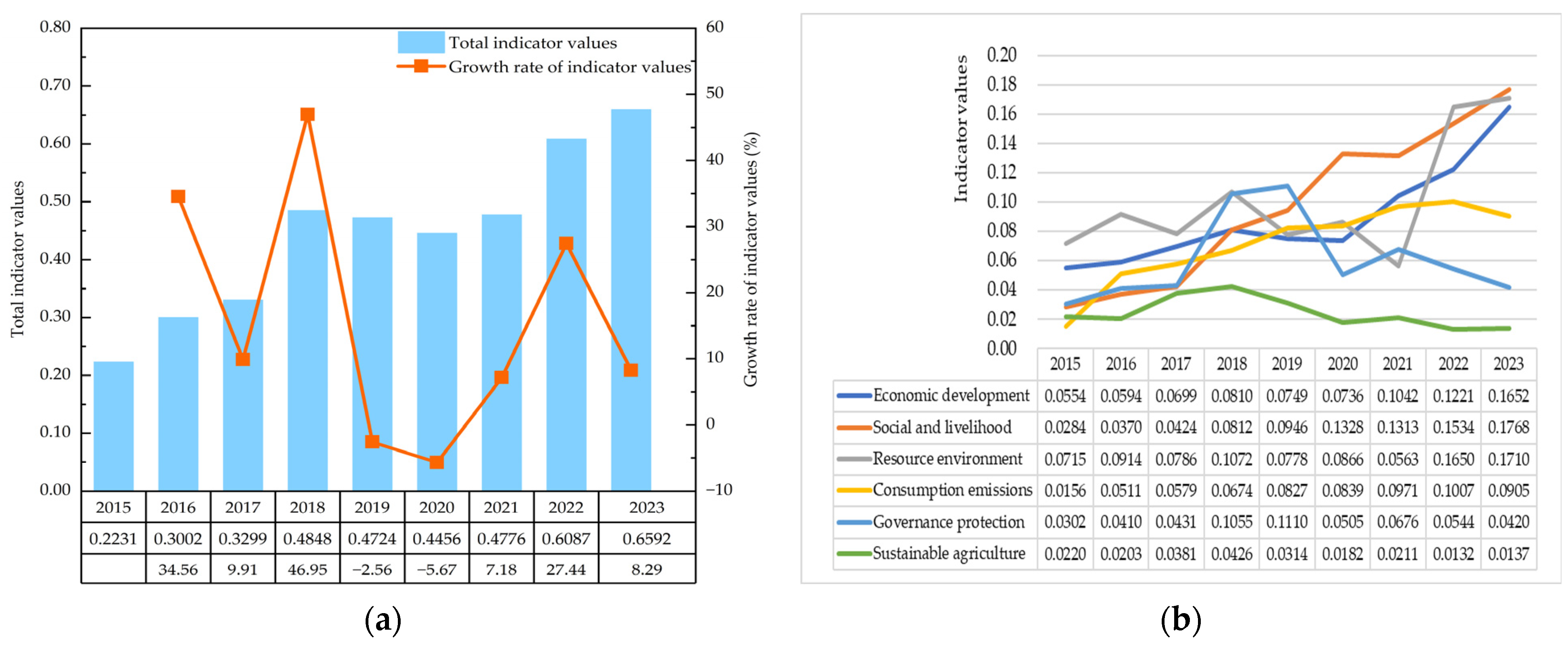



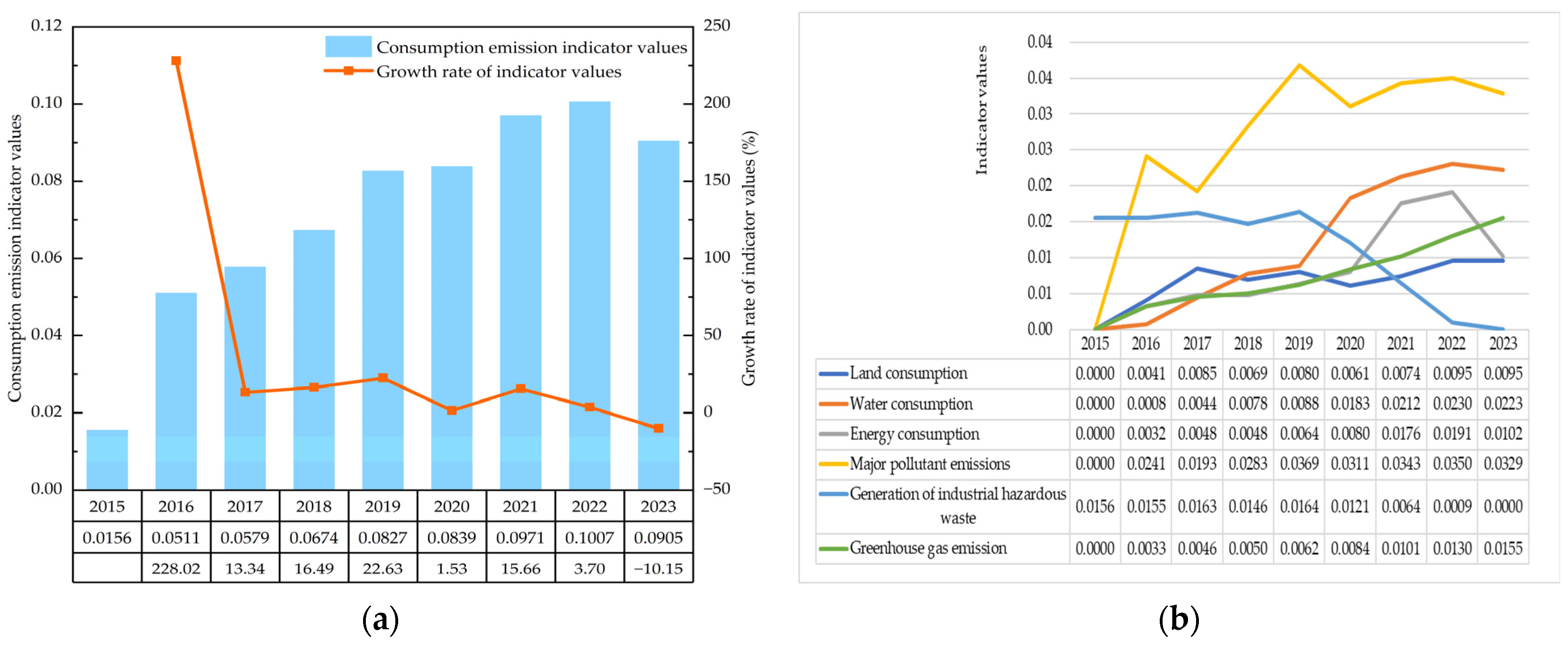
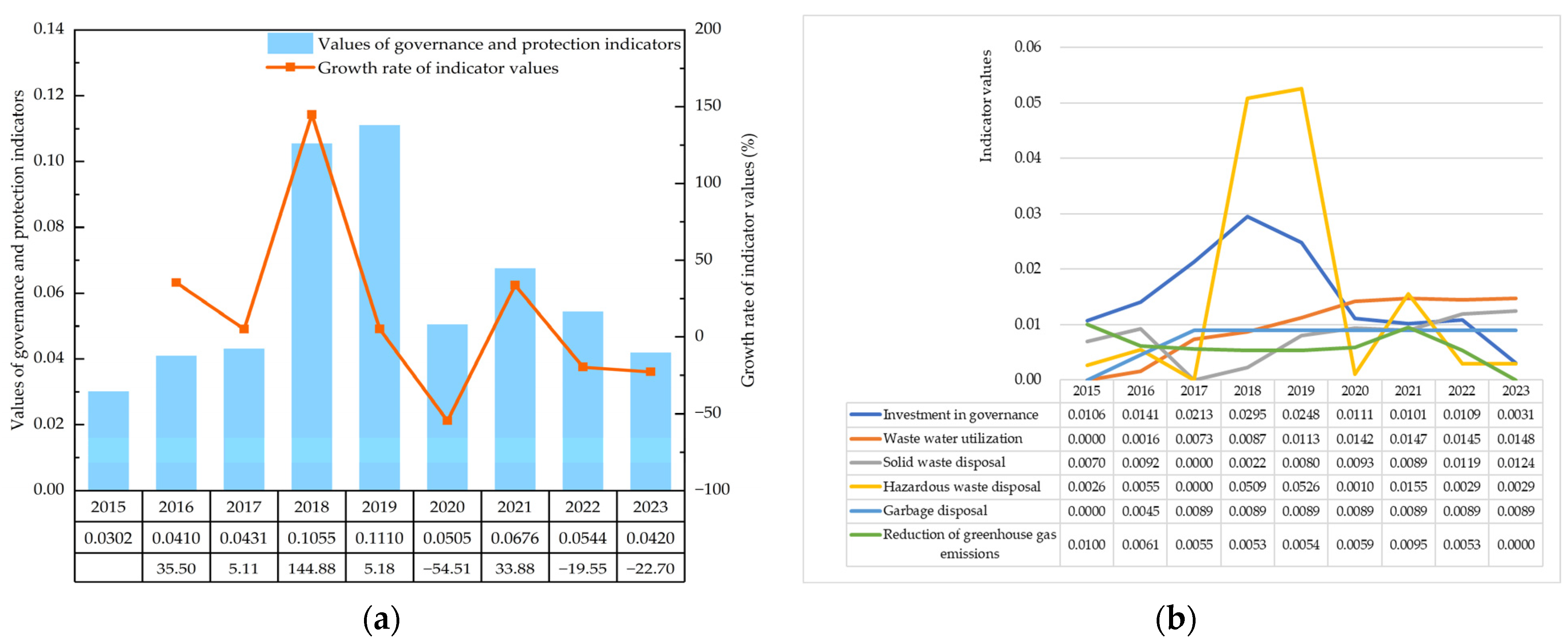

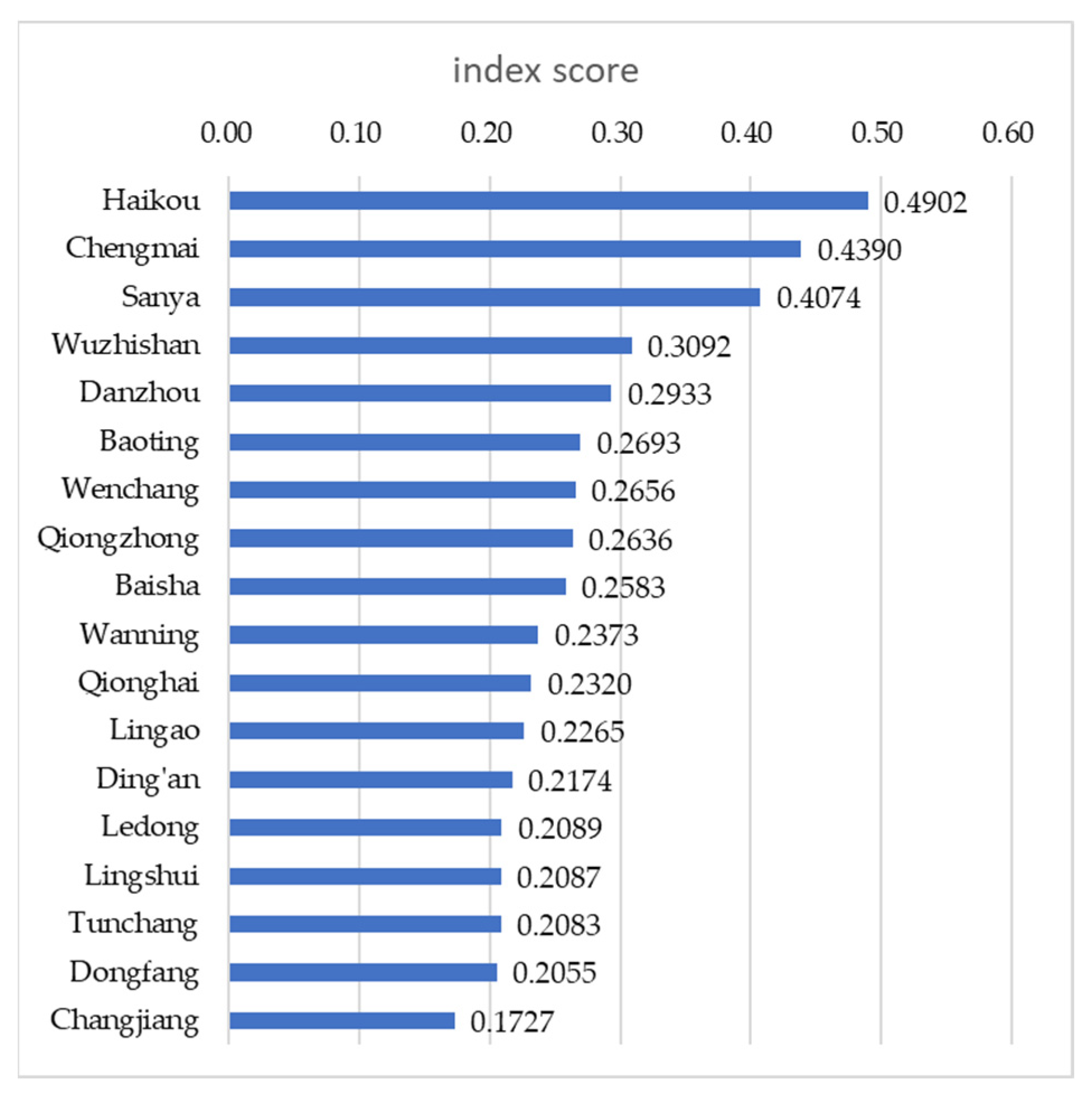
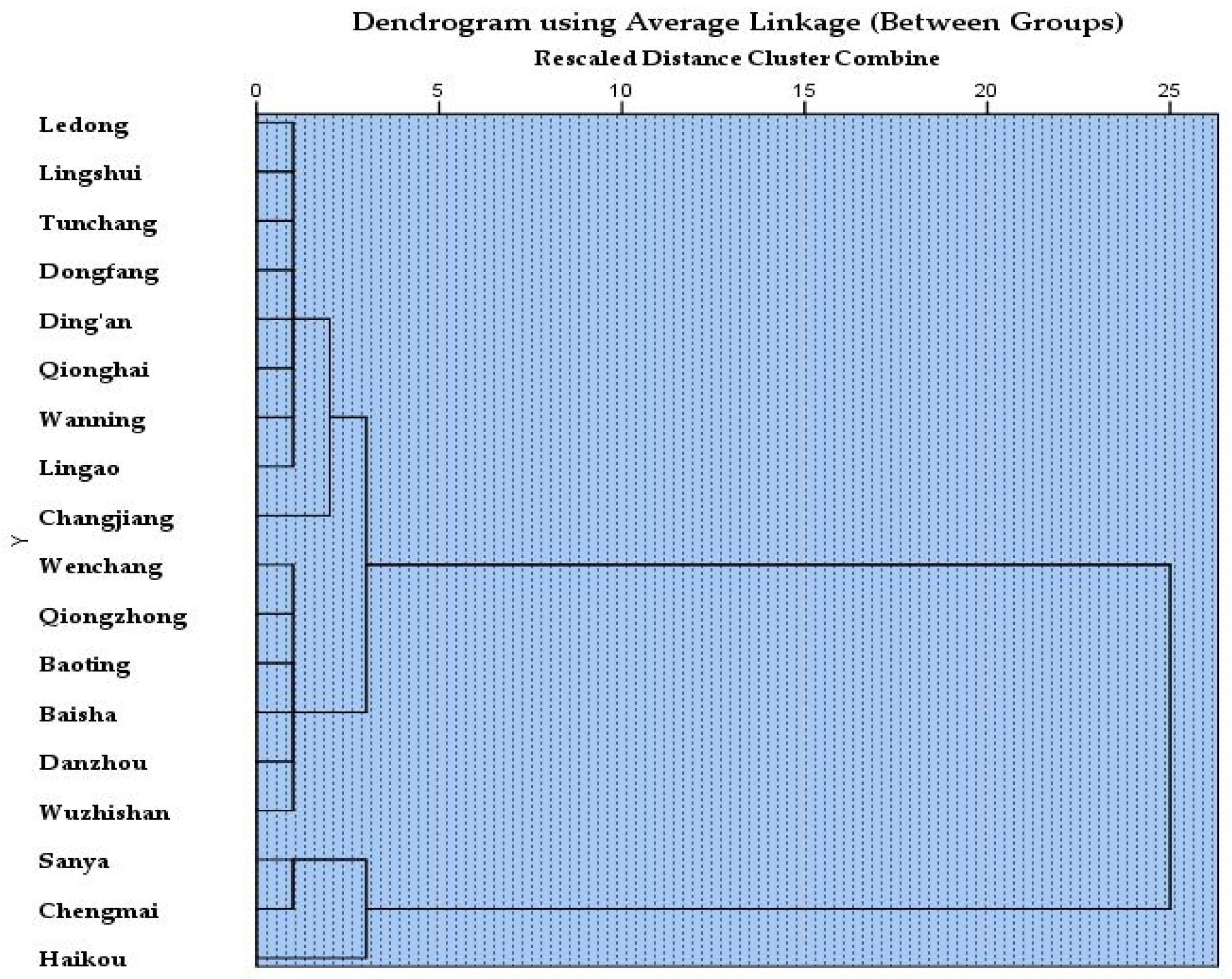

| Primary Index | Secondary Index | Tertiary Index | Index Type | Weight | Indicator Source |
|---|---|---|---|---|---|
| Economic development (A) | Innovation drive (A1) | The proportion of R&D expenditure in GDP (a1) | + | 0.0305 | China Statistical Yearbook on Science and Technology (2016–2024) |
| Effective patent ownership of inventions per 10,000 population (a2) | + | 0.0354 | China Statistical Yearbook on Science and Technology; Hainan Statistical Yearbook (2016–2024) | ||
| Structural optimization (A2) | The ratio of main business income to industrial value added in high-tech industries (a3) | + | 0.0220 | China Statistical Yearbook on Science and Technology; China Statistical Yearbook (2016–2024) | |
| The proportion of e-commerce in GDP (a4) | + | 0.0339 | China Statistical Yearbook (2016–2024) | ||
| Stable growth (A3) | GDP growth rate (a5) | + | 0.0206 | China Statistical Yearbook (2016–2024) | |
| Total labor productivity (a6) | + | 0.0200 | Hainan Statistical Yearbook (2016–2024) | ||
| The proportion of the working-age population in the total population (a7) | + | 0.0335 | Hainan Statistical Yearbook (2016–2024) | ||
| Open development (A4) | Actual utilization of foreign capital per capita (a8) | + | 0.0118 | Hainan Statistical Yearbook (2016–2024) | |
| Total exports and imports per capita (a9) | + | 0.0206 | China Statistical Yearbook (2016–2024) | ||
| Social and livelihood (B) | Education and culture (B1) | The proportion of education expenditure in GDP (b10) | + | 0.0195 | China Statistical Yearbook (2016–2024) |
| Average years of education (population aged 6 and above) (b11) | + | 0.0274 | Hainan Statistical Yearbook (2016–2024) | ||
| Number of public cultural institutions per 10,000 persons (b12) | + | 0.0122 | China Statistical Yearbook of Culture, Heritage and Tourism; Hainan Statistical Yearbook (2016–2024) | ||
| Social security (B2) | Basic social security coverage rate (b13) | + | 0.0217 | China Statistical Yearbook (2016–2024) | |
| Per capita expenditure on social security and employment (b14) | + | 0.0302 | China Statistical Yearbook (2016–2024) | ||
| Hygiene and health (B3) | Per capita government health expenditure (b15) | + | 0.0206 | China Statistical Yearbook (2016–2024) | |
| The total incidence rate of Class A and B notifiable infectious diseases (1/100,000) (b16) | − | 0.0078 | China Health Statistical Yearbook; Hainan Statistical Yearbook (2016–2024) | ||
| Number of health technicians per thousand population (b17) | + | 0.0180 | China Statistical Yearbook (2016–2024) | ||
| Degree of parity (B4) | Poverty incidence rate (b18) | − | 0.0131 | Poverty Monitoring Report of Rural China (2016–2020) | |
| The ratio of disposable income of urban and rural residents (b19) | − | 0.0303 | China Statistical Yearbook (2016–2024) | ||
| Resource environment (C) | Land resources (C1) | Forest coverage rate (c20) | + | 0.0266 | China Statistical Yearbook (2016–2024) |
| Cultivated land coverage rate (c21) | + | 0.0498 | China Statistical Yearbook; Hainan Statistical Yearbook (2016–2024) | ||
| Coverage rate of wetland (c22) | + | 0.0977 | Hainan Statistical Yearbook (2016–2024) | ||
| Grassland coverage rate (c23) | + | 0.0419 | China Statistical Yearbook; Hainan Statistical Yearbook (2016–2024) | ||
| Water environment (C2) | Per capita water resources (c24) | + | 0.0179 | China Statistical Yearbook (2016–2024) | |
| Percentage of water quality sections in river basins with water quality categories I, II, and III nationwide (c25) | + | 0.0192 | Hainan Ecological and Environmental Bulletin (2015–2023) | ||
| Atmospheric environment (C3) | Percentage of overall good ambient air quality days in the province (c26) | + | 0.0146 | Hainan Ecological and Environmental Bulletin (2015–2023) | |
| Consumption and emission (D) | Land consumption (D1) | Value added of secondary and tertiary industries per unit of construction land area (d27) | + | 0.0095 | China Statistical Yearbook, China Urban Construction Statistical Yearbook (2016–2024) |
| Water consumption (D2) | Water consumption per unit of industrial-added value (d28) | − | 0.0230 | China Statistical Yearbook (2016–2024) | |
| Energy consumption (D3) | Energy consumption per unit of GDP (d29) | − | 0.0191 | Hainan Statistical Yearbook (2016–2024) | |
| Major pollutant emission (D4) | Chemical Oxygen Demand (COD) emissions per unit of GDP (d30) | − | 0.0113 | China Energy Statistical Yearbook (2016–2024) | |
| Ammonia and nitrogen emissions per unit of GDP (d31) | − | 0.0089 | China Energy Statistical Yearbook (2016–2024) | ||
| Sulfur dioxide emissions per unit of GDP (d32) | − | 0.0088 | China Energy Statistical Yearbook (2016–2024) | ||
| NOx emissions per unit of GDP (d33) | − | 0.0111 | China Energy Statistical Yearbook (2016–2024) | ||
| Generation of industrial hazardous waste (D5) | Hazardous waste generation per unit of GDP (d34) | − | 0.0164 | China Statistical Yearbook; China Statistical Yearbook on Environment (2016–2024) | |
| Greenhouse gas emission (D6) | The proportion of renewable energy power consumption in the total electricity consumption of the whole society (d35) | + | 0.0155 | National Energy Administration (NEA) (2015–2023) | |
| Governance and protection (E) | Investment in governance (E1) | The proportion of fiscal expenditure on energy conservation and environmental protection in GDP (e36) | + | 0.0165 | China Statistical Yearbook (2016–2024) |
| The ratio of investment in environmental pollution control to investment in fixed assets (e37) | + | 0.0162 | China Statistical Yearbook; Hainan Statistical Yearbook (2016–2024) | ||
| Wastewater utilization rate (E2) | Urban sewage treatment rate (e38) | + | 0.0148 | China Statistical Yearbook on Environment (2016–2024) | |
| Solid waste disposal (E3) | Comprehensive utilization rate of general industrial solid waste (e39) | + | 0.0124 | China Statistical Yearbook on Environment (2016–2024) | |
| Hazardous waste disposal (E4) | Hazardous waste disposal rate (e40) | + | 0.0526 | China Statistical Yearbook on Environment (2016–2024) | |
| Garbage disposal (E5) | Non-hazardous treatment rate of domestic waste (e41) | + | 0.0089 | China Statistical Yearbook on Environment (2016–2024) | |
| Reduction in greenhouse gas emission (E6) | Annual rate of reduction in energy intensity (e42) | + | 0.0100 | Hainan Statistical Yearbook (2016–2024) | |
| Sustainable agriculture (F) | Level of agricultural productivity (F1) | Index of total agricultural output value (f43) | + | 0.0123 | Hainan Statistical Yearbook (2016–2024) |
| Proportion of crop production affected by disasters (F2) | Proportion of the disaster area of tropical agricultural land (f44) | − | 0.0078 | China Rural Statistical Yearbook (2016–2024) | |
| Regional agricultural production capacity per capita (F3) | Per capita area of tropical agricultural land (f45) | + | 0.0283 | China Rural Statistical Yearbook (2016–2024) |
| Class Order | Cities and Counties in Hainan Province | Score Range | Category |
|---|---|---|---|
| Category 1 | Haikou, Chengmai, Sanya | >0.40 | Pioneer development area |
| Category 2 | Wuzhishan, Danzhou, Baisha, Baoting, Qiongzhong, Wenchang | 0.25~0.31 | Stable development area |
| Category 3 | Changjiang, Lingao, Wanning, Qionghai, Ding’an, Dongfang, Tunchang, Lingshui, Ledong | 0.17~0.24 | General development area |
| Type | Source and Year |
|---|---|
| Annual work reports | Work reports of Hainan Provincial People’s Government, 2015–2023 |
| Hainan Province sustainable development-related policy documents | Hainan Province policy document database, 2015–2023 Compilation of policy documents on the construction of Hainan Free Trade Port, 2018–2023 |
| Primary Code | Secondary Code | No. of Reports | Tertiary Code (Keywords) |
|---|---|---|---|
| Economic development | Innovation drive | 8 | Talent introduction, Innovation-driven development, Science and technology innovation |
| Structural optimization | 9 | Structural upgrading, Supply-side structural reform, High-quality development | |
| Stable growth | 3 | Stabilizing the broader economy, Economic recovery | |
| Open development | 7 | Reform and opening-up, Cross-border e-commerce, Active utilization of foreign investment, Foreign trade development, Construction of Hainan free trade port | |
| Social and livelihood | Education and culture | 6 | Establishment of education, Vocational education, Introduction of educational resources, Educational reform, Tourism and culture |
| Social security | 6 | Social insurance for poverty alleviation, Stable employment, Unemployment protection, Assistance for persons with disabilities, Social assistance | |
| Hygiene and health | 5 | Medical and health service system, Health care, “Good director, good doctor”, Chinese medicine inheritance | |
| Degree of parity | 6 | Poverty eradication, Rural revitalization, Poor persons with disabilities, Urban-rural gap | |
| Ecological environment (C) | — | 7 | Forest harvesting quota, Green development of assembled buildings, Water resource utilization and conservation, Land resource planning, Forestry ecological restoration and wetland protection, Peak carbon implementation |
| Social governance (D) | — | 7 | Social order maintenance, Social conflict resolution, Social group management, Social environment creation, Social risk prevention and control, Social participation and collaborative governance |
Disclaimer/Publisher’s Note: The statements, opinions and data contained in all publications are solely those of the individual author(s) and contributor(s) and not of MDPI and/or the editor(s). MDPI and/or the editor(s) disclaim responsibility for any injury to people or property resulting from any ideas, methods, instructions or products referred to in the content. |
© 2025 by the authors. Licensee MDPI, Basel, Switzerland. This article is an open access article distributed under the terms and conditions of the Creative Commons Attribution (CC BY) license (https://creativecommons.org/licenses/by/4.0/).
Share and Cite
Xu, X.; Yang, H. Analyzing the Effective Contributions of Local Governments in Promoting Regional Sustainable Development: Evidence from Hainan, China. Sustainability 2025, 17, 5173. https://doi.org/10.3390/su17115173
Xu X, Yang H. Analyzing the Effective Contributions of Local Governments in Promoting Regional Sustainable Development: Evidence from Hainan, China. Sustainability. 2025; 17(11):5173. https://doi.org/10.3390/su17115173
Chicago/Turabian StyleXu, Xiaolin, and Hezhen Yang. 2025. "Analyzing the Effective Contributions of Local Governments in Promoting Regional Sustainable Development: Evidence from Hainan, China" Sustainability 17, no. 11: 5173. https://doi.org/10.3390/su17115173
APA StyleXu, X., & Yang, H. (2025). Analyzing the Effective Contributions of Local Governments in Promoting Regional Sustainable Development: Evidence from Hainan, China. Sustainability, 17(11), 5173. https://doi.org/10.3390/su17115173




